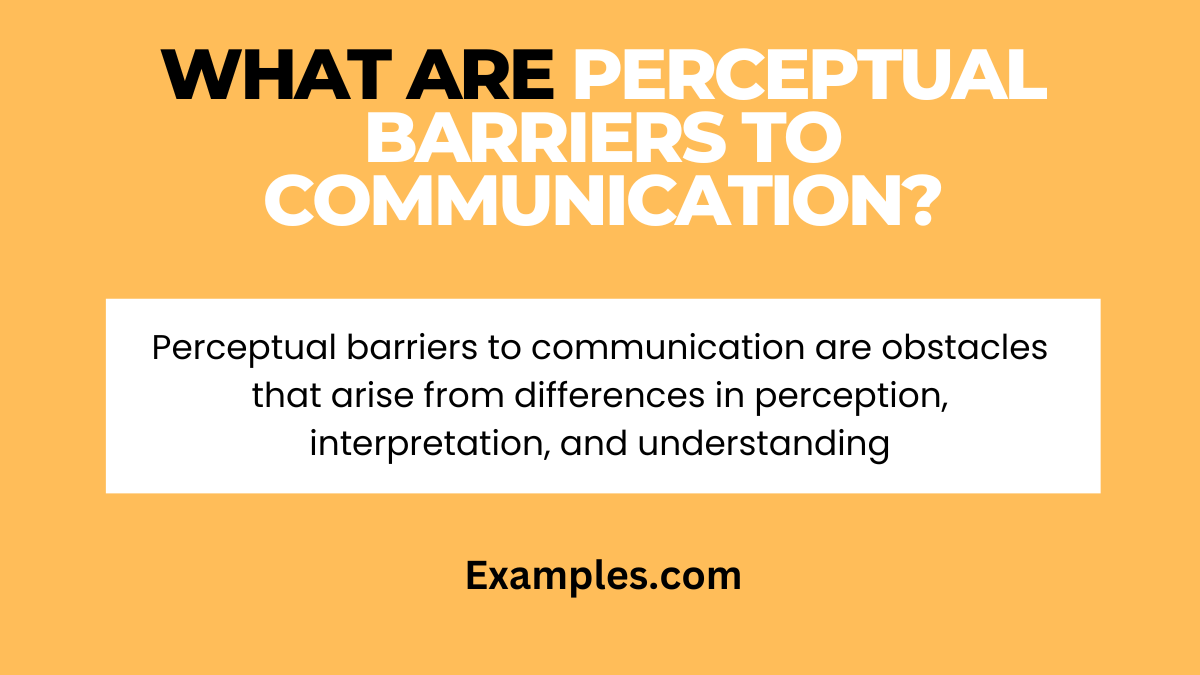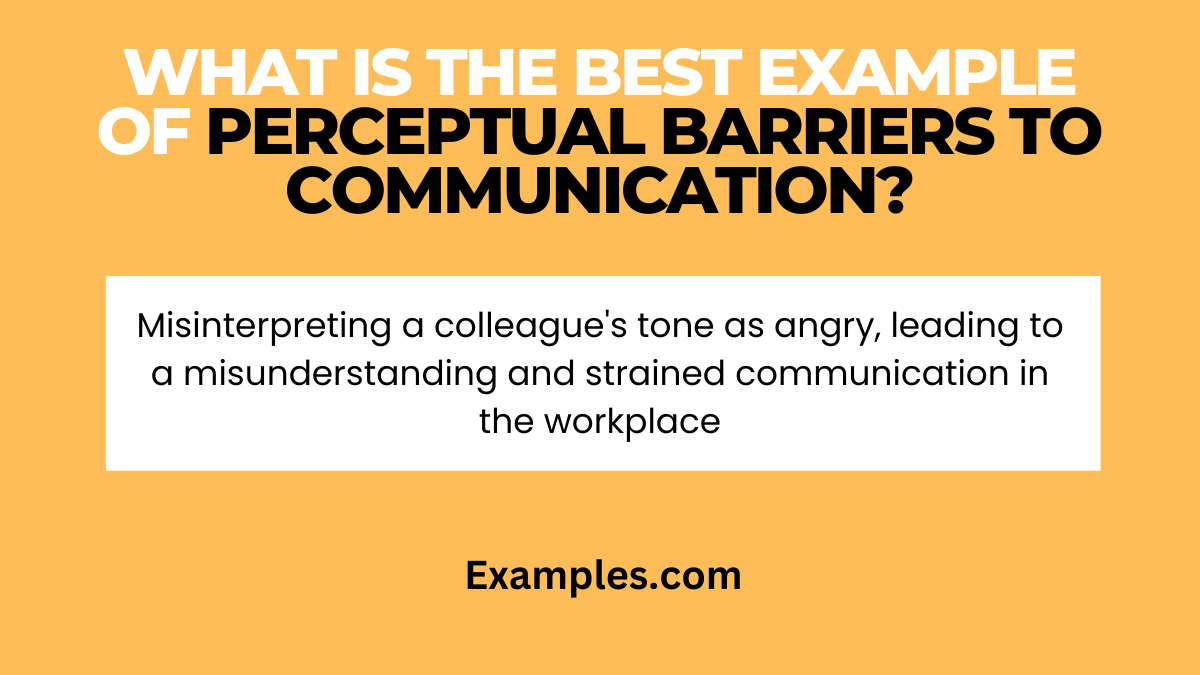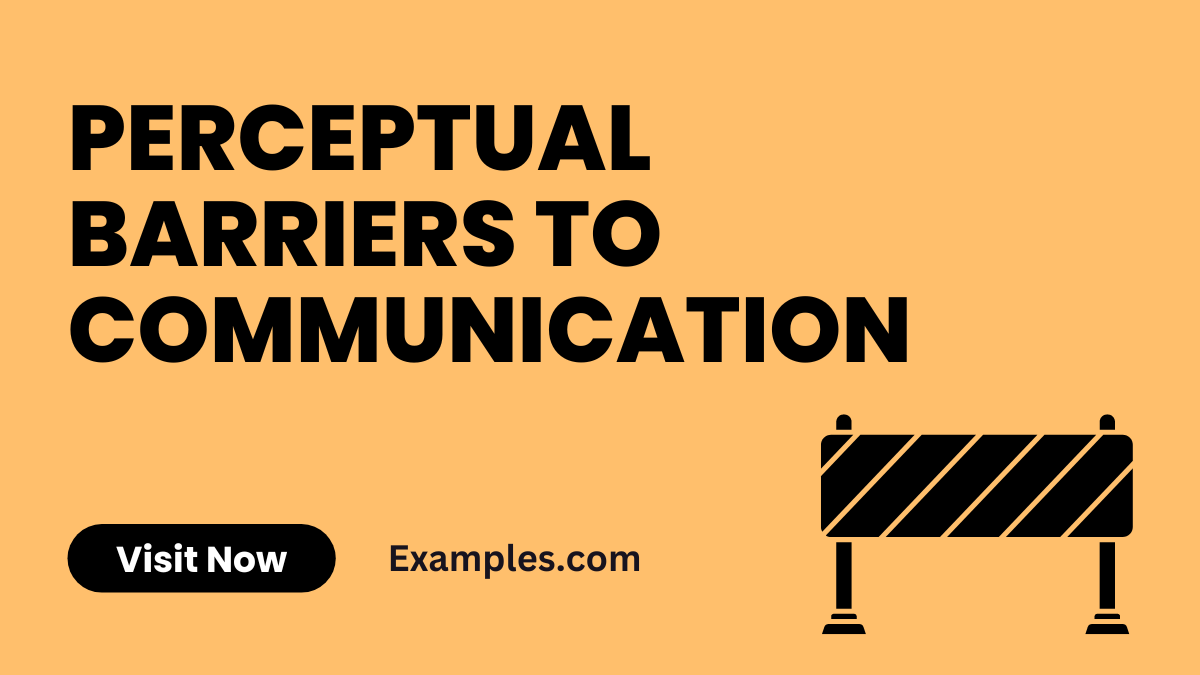19+ Perceptual Barriers to Communication Examples
Perceptual Barriers to Communication involve obstacles created by personal interpretations, beliefs, and biases that can significantly impact how messages are received and understood. These barriers can lead to misunderstandings, misinterpretations, and ineffective communication, particularly in diverse settings. Understanding these barriers is key to improving communication skills. This guide explores the concept of perceptual barriers, their impact on communication, and practical approaches to manage and mitigate these challenges, ensuring more effective and accurate exchanges of information.
What are Perceptual Barriers to Communication?

Perceptual Barriers to Communication refer to the internal filters through which we interpret and give meaning to information, influenced by our experiences, beliefs, and values. These barriers can include preconceptions, assumptions, and interpretations that may not align with the intent of the speaker. Recognizing and addressing these barriers is crucial for clear and effective communication, as they can lead to misunderstandings and hinder the process of accurately conveying and receiving messages.
What is the Best Example of Perceptual Barriers to Communication?

A prime example of Perceptual Barriers to Communication is when two individuals interpret the same information differently due to their unique backgrounds and experiences. For instance, a constructive critique by a manager may be perceived as criticism by an employee, leading to defensive reactions. This scenario underscores the need for clear, empathetic communication and an understanding of how individual perceptions can influence the interpretation of messages, impacting overall communication effectiveness.
20 Examples of Perceptual Barriers to Communication
Perceptual Barriers to Communication are obstacles caused by people’s subjective perceptions and interpretations, which can significantly impact the effectiveness of communication. These barriers arise from individual experiences, beliefs, attitudes, and cultural backgrounds, leading to misunderstandings and misinterpretations. Recognizing and addressing these perceptual differences is key to fostering clear and empathetic communication, essential in both personal and professional interactions.
- Stereotyping Based on Appearance: Judging someone’s capabilities based on their looks.
Example: “Let’s focus on skills rather than appearances in our assessments.” - Assuming Intentions Based on Cultural Background: Misinterpreting actions due to cultural stereotypes.
Example: “I want to understand your perspective better; can you explain more?” - Misunderstanding Due to Personal Biases: Personal beliefs affecting interpretation of information.
Example: “I realize my opinion may be biased; let’s consider other viewpoints.” - Selective Perception in Listening: Hearing what one expects or wants to hear.
Example: “Let’s make sure we understand each other’s points fully.” - Jumping to Conclusions Without Full Information: Making assumptions without all facts.
Example: “Let’s gather more information before drawing conclusions.” - Projection of Personal Experiences: Assuming others feel or think the same way.
Example: “I may have projected my experiences onto you; what’s your actual view?” - Language and Accent Bias: Making assumptions based on how someone speaks.
Example: “Your accent is new to me; could you clarify that point?” - Overgeneralizing from One Experience: Applying one experience to all similar situations.
Example: “This situation might be different from the one we encountered before.” - Influence of Emotional State: Emotions clouding judgment and interpretation.
Example: “I’m aware I’m quite emotional now; let’s discuss this when I’m calmer.” - Assumptions Based on Professional Background: Expecting certain behaviors due to one’s job.
Example: “Your profession might give you a unique perspective on this.” - Inattention and Distraction During Communication: Missing key points due to lack of focus.
Example: “Let’s minimize distractions to ensure we understand each other.” - Preconceived Notions About a Topic: Biases influencing understanding of a subject.
Example: “I’ll try to set aside my preconceptions to understand this better.” - Cultural Misinterpretations: Misreading behaviors due to cultural differences.
Example: “Could you explain how this is typically approached in your culture?” - Interpreting Silence as Agreement or Disagreement: Misreading non-verbal cues.
Example: “I notice you’re silent; does that mean you agree?” - Expecting Others to Share Similar Values and Beliefs: Assuming commonality where there might be none.
Example: “I realize now that we might value different things.” - Influence of Past Experiences on Present Situations: Past shaping current understanding.
Example: “Let’s consider this situation independently of our past experiences.” - Misinterpreting Non-Verbal Signals: Body language leading to wrong conclusions.
Example: “Your gesture seemed hesitant; what are your actual thoughts?” - Assumptions Based on Socioeconomic Status: Expectations influenced by one’s economic background.
Example: “I shouldn’t assume your preferences based on your background.” - Gender Bias in Interpreting Messages: Gender affecting how messages are received.
Example: “Let’s ensure we’re not letting gender biases affect our communication.” - Age-Based Assumptions Affecting Communication: Expectations influenced by age.
Example: “Your age doesn’t define your expertise; let’s focus on your ideas.”
Addressing these Perceptual Barriers to Communication is crucial for achieving effective and inclusive communication, fostering an environment of mutual understanding and respect.
Perceptual Barriers to Communication in the Workplace
In the workplace, perceptual barriers to communication often arise from individual viewpoints, experiences, and biases, impacting how employees interpret messages and interact with each other. Overcoming these barriers is essential for fostering effective communication and collaboration.
- Cultural Misinterpretations: Diverse cultural backgrounds leading to different interpretations of behavior or speech.
- Generational Differences: Varied perceptions and communication styles across different age groups.
- Professional Hierarchies: Preconceptions based on job titles affecting open communication.
- Individual Biases: Personal experiences and biases skewing understanding of colleagues’ actions.
- Misreading Body Language: Incorrect interpretations of non-verbal cues based on personal perceptions.
- Projecting Personal Emotions: Misattributing one’s emotions or motives to others’ actions or words.
- Selective Hearing: Focusing only on parts of the message that align with personal beliefs.
- Language Barriers: Variances in language proficiency leading to different understandings of discussions.
Recognizing and addressing these perceptual barriers is crucial for ensuring clear, unbiased, and effective communication within the workplace.
Types of Perceptual Barriers to Communication

Perceptual barriers in communication arise from how individuals interpret and understand information based on their perceptions. These barriers can significantly affect the clarity and effectiveness of communication.
- Stereotyping: Making assumptions based on generalized beliefs about groups of people.
- Selective Perception: Focusing on specific aspects of communication based on personal interests or beliefs.
- Projection: Attributing one’s own feelings, motives, or biases to others.
- Expectations: Preconceived notions influencing how messages are received and interpreted.
- Misinterpretation of Non-Verbal Cues: Misunderstanding body language or facial expressions.
- Cultural Misunderstandings: Differences in cultural backgrounds leading to varied interpretations.
- Language Differences: Variances in language use affecting perception and understanding.
- Mental Filters: Personal experiences and emotions filtering how information is processed.
Understanding these types of perceptual barriers is crucial for identifying and addressing communication challenges.
How do Perceptual Barriers Affect Communication?
Perceptual barriers can significantly impact the process and effectiveness of communication, often leading to misunderstandings and conflicts.
- Misunderstandings: Different perceptions can lead to misinterpretation of messages.
- Reduced Clarity: Perceptual filters can obscure the intended meaning of communication.
- Conflict: Varied interpretations can result in disagreements and disputes.
- Distorted Feedback: Perceptions can influence the feedback, making it biased or inaccurate.
- Ineffective Decision Making: Misinterpretations can lead to poor decisions.
- Lack of Empathy: Failure to understand others’ perspectives can hinder empathetic communication.
- Breakdown in Relationships: Ongoing misunderstandings can strain personal and professional relationships.
- Barrier to Learning: Perceptual barriers can prevent the accurate understanding of new information.
Recognizing the effects of perceptual barriers is essential for effective communication.
How to Overcome Perceptual Barriers in Communication?
Overcoming perceptual barriers requires effort and strategies to ensure communication is clear, empathetic, and effective.
- Active Listening: Pay close attention to fully understand the speaker’s message.
- Empathy: Try to understand the perspectives and feelings of others.
- Openness to Feedback: Be receptive to others’ viewpoints and constructive criticism.
- Self-awareness: Recognize and reflect on your own biases and perceptions.
- Clarification: Ask questions to clarify understanding and avoid assumptions.
- Cultural Sensitivity: Be aware of and respect cultural differences in communication.
- Avoiding Stereotypes: Refrain from making generalized judgments about others.
- Mindful Communication: Be present and thoughtful in your interactions.
Adopting these methods helps in minimizing the impact of perceptual barriers, facilitating smoother communication.
Effectively addressing Perceptual Barriers to Communication is essential for fostering clear, empathetic, and inclusive interactions. By being aware of and actively working to overcome these barriers, we can enhance our understanding and improve communication in both personal and professional contexts. This guide serves as a valuable resource for recognizing and navigating the complex landscape of perceptual barriers, leading to more effective and meaningful exchanges.



